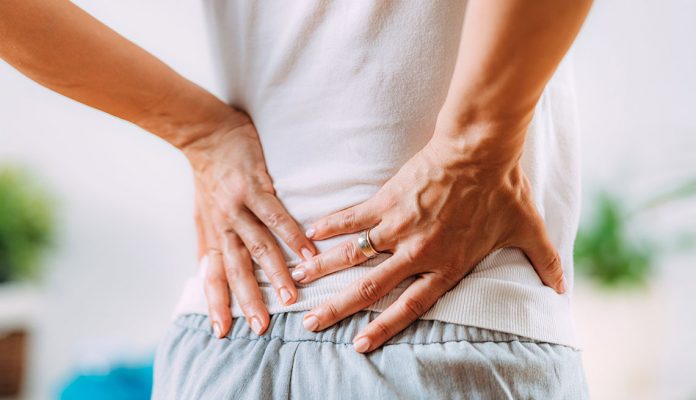Lower back pain, sometimes called lumbago, is not a specific disease diagnosis. It’s a symptom of several different types of medical problems.
It usually results from a problem with one or more parts of the lower back, such as:
ligaments and muscles
discs
intervertebral discs
nerves
the bony structures that make up the spine, called vertebral bodies or vertebrae
It can also be due to a problem with nearby organs, such as the kidneys.
According to the American Association of Neurological Surgeons, 75 to 85 percent of Americans will experience back pain in their lifetime. Of those, 50 percent will have more than one episode within a year.
In 90 percent of all cases, the pain gets better without surgery. Talk with a doctor if you’re experiencing back pain.
Back pain treatment
Many people will not need extensive treatment for back pain. Over-the-counter pain medications are often sufficient.
In more severe cases, stronger treatments may be necessary, but they’re typically provided under close supervision from your doctor.
Medication
The majority of back pain episodes are by treatment with nonsteroidal anti-inflammatory drugs (NSAIDs), such as:
ibuprofen (Motrin, Advil)
naproxen (Aleve)
Analgesics, such as acetaminophen (Tylenol), are another category of pain relievers. They are also an option for back pain, though they don’t have the anti-inflammatory properties.
Be careful with medications like ibuprofen if you have kidney problems or stomach ulcers.
Never take more than the recommended dose of over-the-counter medications without a doctor’s recommendation, as even these medications may have severe side effects if taken
incorrectly.
Topical rubs and ointments
Topical products may be highly effective at reducing back pain. Many of these contain ingredients like ibuprofen and lidocaine and come in the form of:
gels
lotions
creams
patches
sprays
Muscle relaxants
Muscle relaxants can also be used for lower back pain, especially if muscle spasms occur alongside pain. These medications act on the central nervous system to reduce pain.
Antidepressants
Antidepressants and other medications can sometimes be used off-label for the treatment of back pain.
If your back pain is severe, your doctor may prescribe amitriptyline, a tricyclic antidepressant, because it focuses on different parts of the pain response. This antidepressant may also work better for nerve-related pain.
Steroid injections
Your doctor might also recommend cortisone steroid injections for certain causes of back pain. For example, a person with back pain that involves a nerve may get a cortisone steroid injection.
Opioids
Opioids are stronger pain medications that can be prescribed for more severe pain. These medications, such as oxycodone (OxyContin) and a combination of acetaminophen and hydrocodone (Vicodin), act on the brain cells and body to reduce pain.
Opioids should be used with caution, however, due to a risk of addiction.
Surgery
Surgery is usually reserved for those with structural abnormalities that haven’t responded to nonsurgical treatment with medication and therapy.
Surgery may be an option for people with:
severe, constant pain with identifiable structural abnormalities
nerve compression that causes muscles to become weak
spinal cord compression that limits daily activities
Alternative medicine
Alternative therapies that may help relieve back pain include:
acupuncture
massage
chiropractic adjustments
cognitive behavioral therapy (CBT)
relaxation techniques
Be sure to talk with your doctor before undergoing any alternative or complementary treatment. If you’re experiencing back pain, these lower back pain treatment options might be helpful.
Back pain home remedies
Many home remedies can be used with traditional back pain treatments. If you have questions about these, talk with your doctor.
Heat and ice therapy
Ice packs may relieve discomfort and help lessen inflammation in short-term phases of back pain. Note: Don’t apply the ice directly to your skin. Wrap it in a thin towel or gauze to prevent damage to your skin.
Warm compresses may also relieve pain when inflammation has gone down. Consider switching between heat and cold.
Exercises
Exercises to improve posture and strengthen the back and abdominal muscles — called the core muscles — are a treatment option that should be strongly considered.
This treatment often involves:
improving posture
using proper lifting techniques
strengthening core muscles
stretching muscles to improve flexibility
A physical therapist can teach you how to perform these types of exercises at home.
Essential oils
suggests that essential oil or ointments made with capsaicin may help decrease pain.
Capsaicin is the ingredient in peppers that makes them hot. These ingredients may desensitize the nerves in the affected area and decrease the pain you feel.
Home remedies may be highly effective at reducing back pain. Learn more about how to use them and how they work.
Back pain causes
The most common causes of lower back pain are strain and problems with back structures.
Strain
Strained muscles often cause back pain. Strain commonly occurs with incorrect lifting of heavy objects and sudden awkward movements.
Strain can also result from overactivity. An example is the sore feeling and stiffness that occurs after a few hours of yard work or playing a sport.
Structural problems
Vertebrae are the interlocking bones stacked on top of one another that make up the spine. Discs are areas of tissue that cushion the spaces between each vertebra. Disc injuries are a fairly cause of back pain.
Sometimes these discs can bulge, herniate, or rupture. Nerves can get compressed when this happens.
Herniated discs can be very painful. A bulging disc pressing on the nerve that travels from your back and down your leg can cause sciatica or irritation of the sciatic nerve. Sciatica can be experienced in your leg as:
pain
tingling
numbness
Arthritis
Spinal osteoarthritis is also a potential cause of back pain. It’s caused by damage and deterioration in the cartilage of joints in your lower back.
Over time, this condition can lead to narrowing of the spinal column, or spinal stenosis.
Osteoporosis
Loss of bone density and thinning of the bone, called osteoporosis, can lead to small fractures in your vertebrae. These fractures can cause serious pain and are referred to as compression fractures.
Other causes of back pain
There are many other potential causes of back pain, but most are rare. Be sure to see a doctor if you experience regular back pain that does not go away.
After ruling out the more common causes of back pain, your doctor will perform tests to determine if you have a rarer cause.
one of the vertebrae moving out of place and onto a nearby vertebra, called degenerative spondylolisthesis
loss of nerve function at the lower spinal cord, called cauda equina syndrome (a medical emergency)
fungal or bacterial infection of the spine, such as Staphylococcus, E. coli, or tuberculosis
cancer or noncancerous (benign) tumor in the spine
kidney infection or kidney stones
Back pain symptoms
Back pain can have many symptoms, including:
a dull, aching sensation in the lower back
a stabbing or shooting pain that can radiate down the leg to the foot
an inability to stand up straight without pain
a decreased range of motion and reduced ability to flex the back
The symptoms of back pain, if due to strain or misuse, are usually short lived but can last for days or weeks.
Back pain is chronic when symptoms have been present for longer than 3 months.
Back pain symptoms that may indicate a serious problem
See your doctor if back pain doesn’t improve within 2 weeks of developing. There are times when back pain can be a symptom of a serious medical problem.
Symptoms that can indicate a more serious medical problem are:
loss of bowel or bladder control
numbness, tingling, or weakness in one or both legs
back pain after trauma (injury), such as a fall or a blow to the back
intense, constant pain that gets worse at night
unexplained weight loss
pain associated with a throbbing sensation in the abdomen
fever
Let your doctor know if you have any of these symptoms.
Back pain diagnosis
A physical exam is typically all that’s needed to diagnose back pain. During the physical exam, your doctor may test your:
ability to stand and walk
spine’s range of motion
reflexes
leg strength
ability to detect sensations in your legs
If a serious condition is suspected, your doctor might order other tests, including:
blood and urine tests to check for underlying conditions
X-rays of the spine to show alignment of your bones and check for breaks
CT scan or MRI scan to assess your discs, muscles, ligaments, nerves, and blood vessels
bone scan to look for abnormalities in the bone tissue
electromyography (EMG) to test nerve signals
How to prevent back pain
These tips can help ease back pain when it happens. They can also help you prevent back pain in the first place.
Carry less
Heavy briefcases, laptop bags, suitcases, and purses can add unnecessary stress and strain to your neck and spine.
Try to reduce what you need to carry, and use bags that distribute the weight more evenly, such as a backpack. If you can, use a bag with wheels to keep weight off your back entirely.
Work your core
The muscles in and around your abdomen and back help keep you upright and carry you through your physical activities. Strengthening them can also reduce the chances of pain, strain, or damage to your back.
Plug strength training workouts with a core focus into your regular fitness routine a few times a week.
Improve your posture
Poor posture can put unnecessary pressure and strain on your spine. Over time, this can lead to pain and damage.
Regularly remind yourself to roll back rounded shoulders and sit upright in your chair.
Change shoes
High-heeled shoes are likely to cause damage to your back if you wear them frequently. Pick comfortable, supportive, and minimally elevated heeled shoes when you can.
Stretch often
Doing the same thing every day can leave your muscles fatigued and more likely to strain. Stretch regularly to help improve circulation in those muscles and lower the risk of back pain and damage.
If you think these five tips are helpful for preventing back pain, read five more ways to help reduce your chances of hurting your back.
Risk factors for back pain
You may have an increased risk for back pain if you:
work in a sedentary (inactive) environment
don’t exercise
engage in high impact activity without stretching or warming up first
are older
have obesity
are a smoker
have been diagnosed with a specific condition like arthritis
Your mental health also has an effect on your risk of back pain. You may be at a higher risk of back pain if you have a stressful job or have depression and anxiety.
Back pain and pregnancy
Back pain during each trimester of your pregnancy can be common, and several causes are to blame. However, you should be sure to talk with your doctor about what you’re experiencing, in case the pain may be part of a bigger problem.
Here are a few reasons why you may be experiencing back pain during pregnancy:
Shifting center of gravity
As your baby grows, the center of your body’s “gravity” moves outward. Your spine and back arch to make up for the change in balance. This put extra stress on the lower lumbar spine.
Weight gain
Weight gain can be a healthy part of pregnancy, but even the little bit you’re likely to gain during those 9 months can put more stress on your back and core muscles.
Hormones
As your body prepares to deliver the baby, it releases hormones that loosen the ligaments that stabilize your pelvis and lumbar spine. These same hormones can cause the bones in your spine to shift, which may lead to discomfort and pain.
Exercises to help your back pain
Gentle stretches and easy exercises can help ease back pain and prevent future problems.
Here are two exercises you can try. These moves require no special equipment and can be performed anywhere you can access an area of open floor. A yoga mat is recommended but not necessary.
Bridges
Yoga for back pain
Yoga may be thought of as a way to reduce stress, but it can also be a great way to ease muscle pain. Certain yoga poses can help stretch and strengthen the muscles in your core and back, too. That can ease pain and prevent future back problems.
Practice these yoga poses for a few minutes every day. They’re great for beginners. You can add new ones later for more strenuous stretching.






























